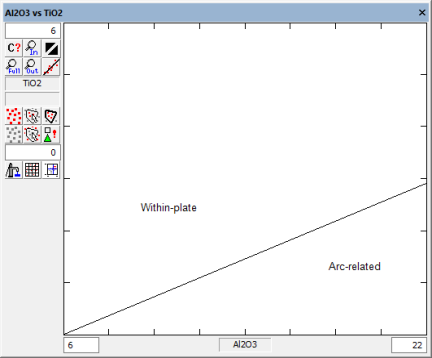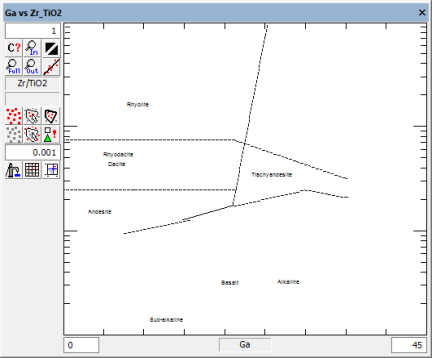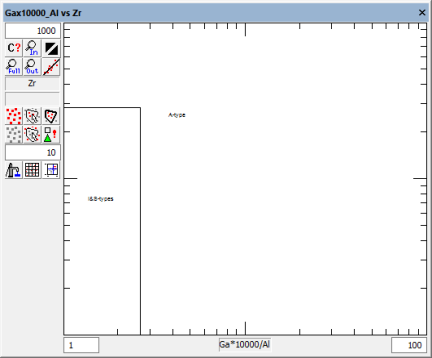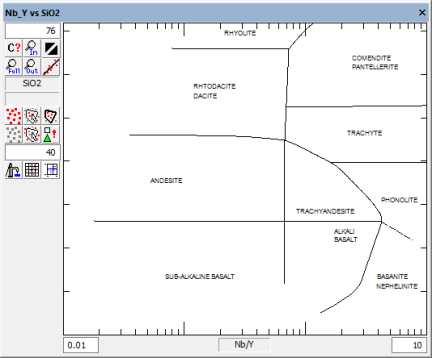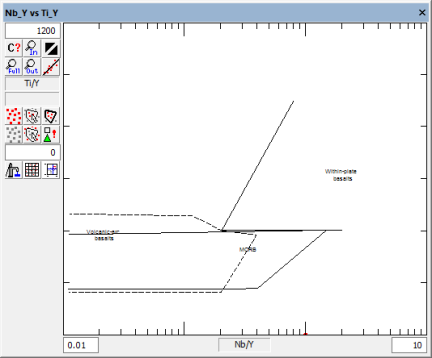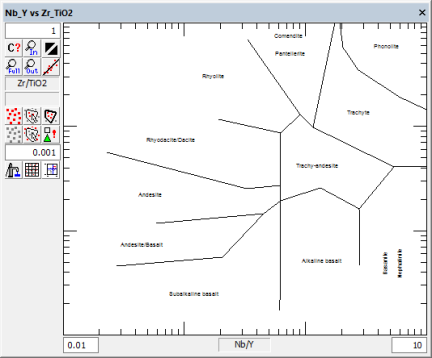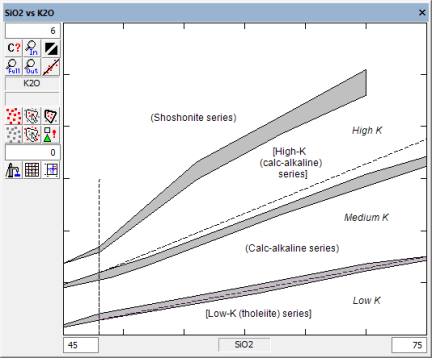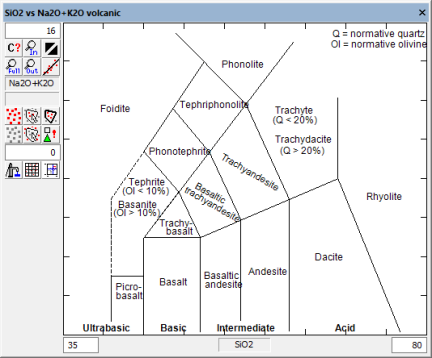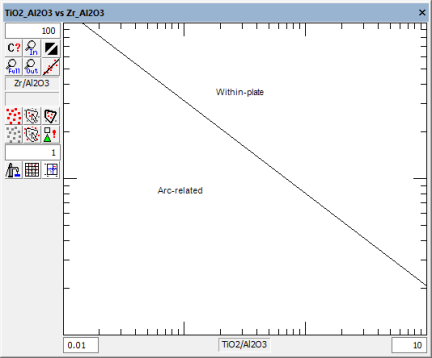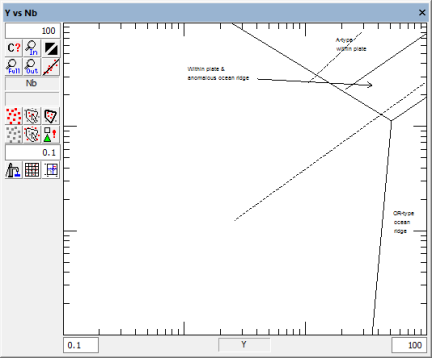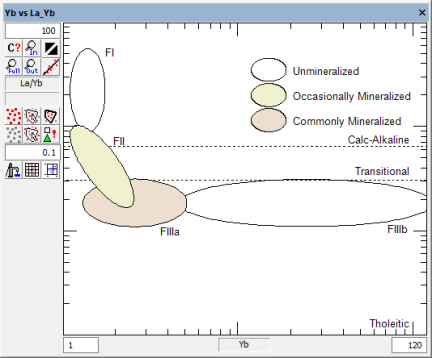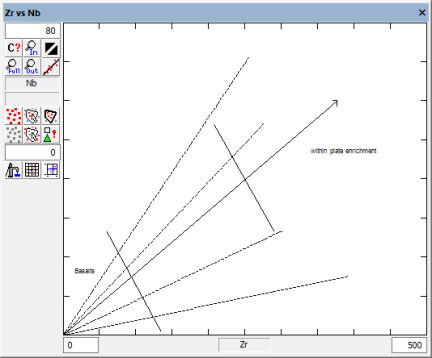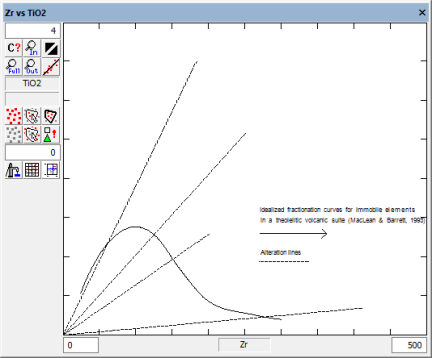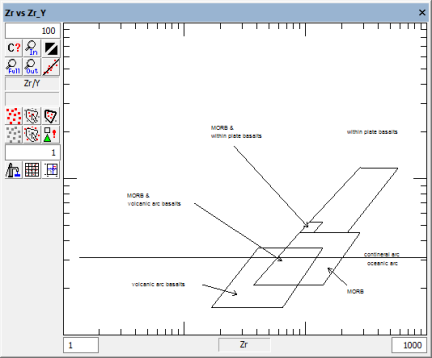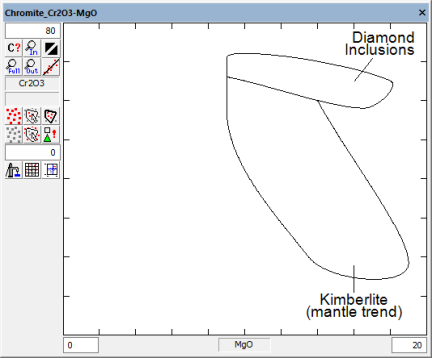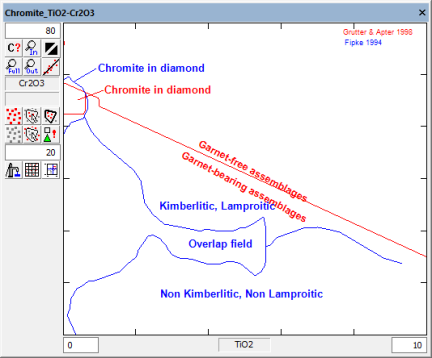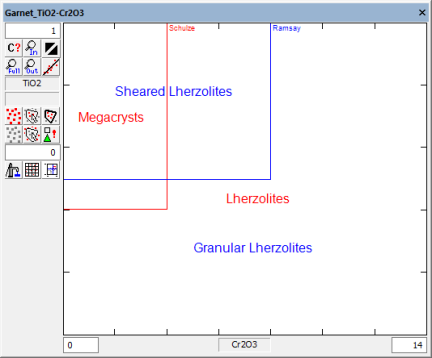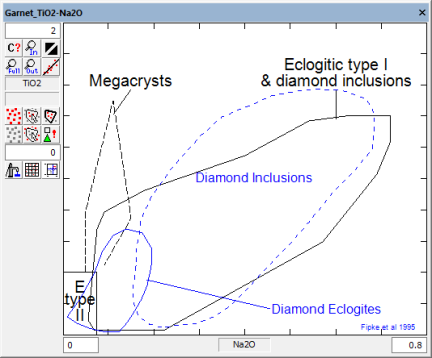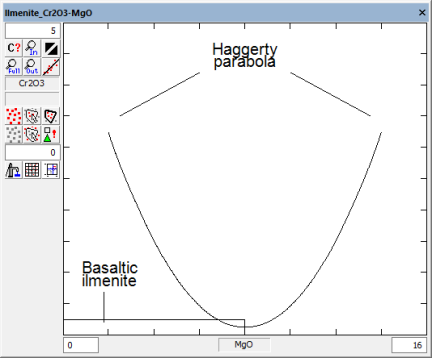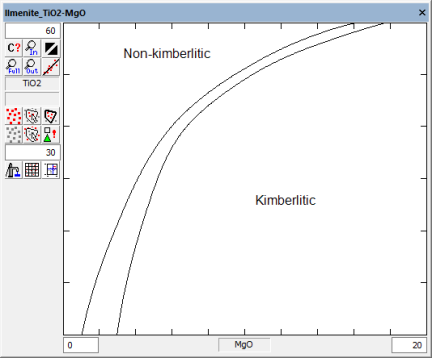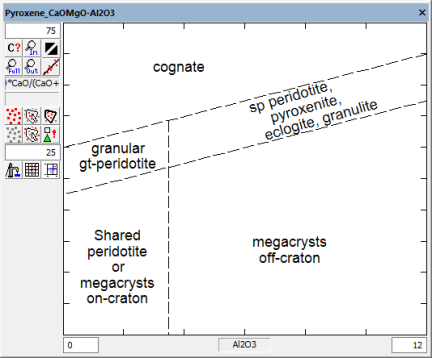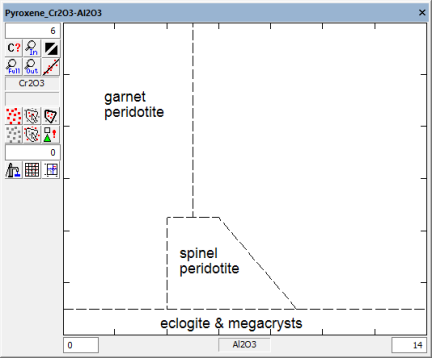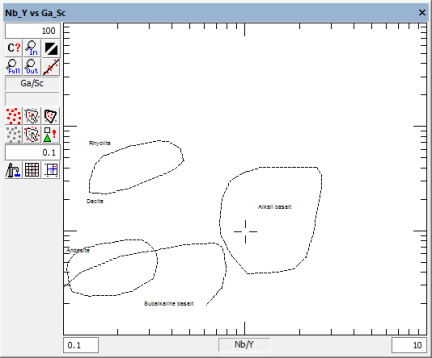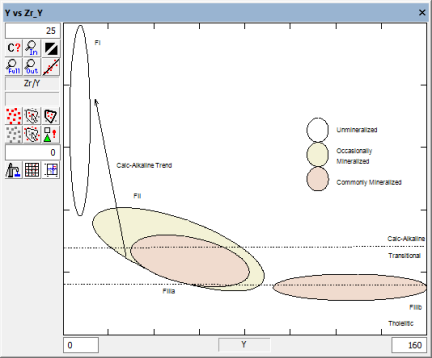Scatter Plot Templates
A Template is a predefined Scatter Plot diagram with set axes and graphical categorization elements. Each Template consists of three files:
- The Template file, "*.geosoft_template", which is a text file that contains information on, for example the channels, scales and titles, as well as the name of the associated overlay file.
- The Overlay file, "*.geosoft_overlay", which is a text file that contains either (i) line/text commands to draw an overlay or (ii) the name of a map file to use as the overlay. In this case, it refers to a map file.
- The Map file, "*_Overlay.map", which is a Geosoft map containing the overlay map items.
These files are stored in the "…/Geosoft/resourcefiles/etc" folder. New or modified Templates and Overlays are stored in the "…/Geosoft/user/etc" folder.
Twenty-eight Bivariate Diagram (Scatter Plot) Templates are included with montaj Geochemistry. They are divided into three categories: Lithological Discrimination, Diamond Exploration and Uncategorized.
Lithological Discrimination Diagrams
The lithological discrimination diagrams include a combination of major and trace element diagrams, as well as some that are useful for volcanic and some that are useful for plutonic rock types.
Al2O3 vs TiO2 - Distinguishes between Within-plate and Arc-related sources
Ga vs Zr_TiO2 - For volcanic discrimination; classifies samples according to major volcanic rock types
Gax10000_Al vs Zr - For granitic discrimination; distinguishes between A-type granites (within plate), and I&S-type (syn-collisional and volcanic arc) granites
Nb_Y vs SiO2 - For volcanic discrimination; classifies samples according to major volcanic rock types using Nb/Y (as an alkalinity indicator) vs SiO2. (After Winchester and Floyd, 1977)
Nb_Y vs Ti_Y - For basalt discrimination; distinguishes between within-plate basalts, MORB and volcanic-arc basalts (dashed line). (After Pearce, 1982)
Nb_Y vs Zr_TiO2 - For alkaline /sub-alkaline basalt discrimination. (After Winchester and Floyd, 1977)
SiO2 vs K2O - For the subdivision of subalkalic rocks. Broken lines and italic labels are after Le Maitre et al., 1989; Labels in parenthesis are after Rickwood, 1989; the shaded bands denote the regions where various boundary lines fall, as summarized by Rickwood, 1989 (lines from Peccerillo and Taylor, 1976; Ewart, 1982; Innocenti et al., 1982; Carr, 1985; and Middlemost, 1985).
SiO2 vs Na2O+K2O plutonic - For the classification of plutonic rocks using total alkalis vs silica (TAS diagram). (After Cox et al., 1979; Wilson, 1989)
SiO2 vs Na2O+K2O volcanic - For the classification of volcanic rocks using total alkalis vs silica (TAS diagram). (After Le Maitre, 1989)
Ti_1000 vs V - For discriminating basalts; groupings are: arc tholeiite, MORB and back-arc basin, and alkali basalts. (After Shervais, 1982)
TiO2_Al2O3 vs Zr_Al2O3 - Distinguishes between Within-plate and Arc-related sources
Y vs Nb - Discrimination diagram for granites, showing fields for volcanic-arc granites, within-plate granites, and ocean-ridge granites. (After Pearce et al., 1984)
Yb vs La_Yb - For differentiation of basalts into calc-alkaline, transitional and tholeiitic
Zr vs Nb - For basalt discrimination; shows increasing within-plate enrichment.
Zr vs TiO2 - Idealized fractionation curves for immobile elements in a tholeiitic volcanic suite. (After MacLean and Barrett, 1993)
Zr vs Y - For differentiation of basalts into calc-alkaline, transitional and tholeiitic.
Zr vs Zr_Y - Discrimination for basalts based on Zr/Y-Zr variations.
Diamond Exploration Diagrams
Chromite_Cr2O3-MgO - For Chromite classification; this diagram identifies and separates mantle trend kimberlites from those with compositions more likely to contain diamond inclusions. (After Gurney et al., 1993; Fipke et al., 1995)
Chromite_TiO2-Cr2O3 - For Chromite classification; this diagram distinguishes between garnet-bearing and garnet free assemblages, and contains fields to separate Kimberlitic, Lamroitic and Non-Kimberlitic and Non-Lamproitic rock types. (After Fipke, 1994; Grutter & Apter, 1998)
Garnet_Gurney - For Garnet classification; this diagram classifies mantle-derived garnets on the basis of Cr2O3 and CaO content. Garnets are grouped by G-number, where G10 garnets (Harzburgitic) are within the diamond facies. (After Gurney, 1984)
Garnet_TiO2-Cr2O3 - For Garnet classification; this diagram identifies the boundary between perioditic and megacrystic garnets. (After Schulze, 2003)
Garnet_TiO2-Na2O - For Garnet classification; this diagram identifies eclogitic and megacrystic type garnets. (After Fipke et al., 1995)
Ilmenite_Cr2O3-MgO - For Ilmenite classification; this diagram identifies basaltic ilmenites
Ilmenite_TiO2-MgO - For Ilmenite classification; this diagram separates kimberlitic ilmenites from non-kimberlitic ilmenites. (After Wyatt et al., 2004)
Pyroxene_CaOMgO-Al2O3 - For Pyroxene classification; this diagram separates pyroxenes into various categories: garnet bearing peridotite, spinel peridotite, megacrysts (on- and off-craton).
Pyroxene_Cr2O3-Al2O3 - For Pyroxene classification; this diagram distinguishes between garnet peridotite, spinel peridotite, eclogite and megacrysts.
Uncategorized
Nb_Y vs Ga_Sc - For volcanic classification
Y vs Zr_Y - For differentiation of basalts into calc-alkaline, transitional and tholeiitic groups
The diagram descriptions are based on Rollinson, H.R. [18]
References
-
[1] Cox, K. G., Bell, J. D. & Pankhurst, R. J., 1979. The Interpretation of Igneous Rocks. George Allen & Unwin.
-
[2] Ewart, A., 1982. The mineralogy and petrology of Tertiary-Recent orogenic volcanic rocks: with special reference to the andesitic-basaltic compositional range. In: R.D.Thorpe (Editor), Andesites: Orogenic Andesites and Related Rocks. Wiley, Chichester, pp. 26-87.
-
[3] Feigenson, M.D., and Carr, M.J., 1985. Determination of major, trace, and rare-earth elements in rocks by DCP-AES: Chemical Geology, v. 51, p. 19-27.
-
[4] Fipke, C.SE., 1994. Significance of chromite, ilmenite, G5 Mg-almandine garnet, zircon, and tourmaline in heavy mineral detection of diamond-bearing lamproite. Proceedings of the 5th International Kimberlite Conference. Vol. 2. Diamonds, Characterization, Genesis and Exploration. Companhia de Pesquisa de Recursos Minerais, Rio de Janeiro, Brazil. 366-381.
-
[5] Fipke, C.E., Gurney, J.J. and Moore, K.O., 1995. Diamond exploration techniques emphasizing indicator mineral geochemistry and Canadian examples; Geological Survey of Canada, Bulletin 423, 85 pages.
-
[6] Gurney, J.J., 1984. A correlation between garnets and diamonds in kimberlites. In: Glover, J.E., Harris, P.G. (Eds.), Kimberlite Occurrence and Origin: A Basis for Conceptual Models in Exploration. Geology Department and University Extension, University of Western Australia, Publication, vol. 8. Blackwell Scientific Publications, Perth, pp. 143-166.
-
[7] Gurney, J.J, Helstaedt, H., Moore, R.O., 1993. A review of the use and application of mantle mineral geochemistry in diamond exploration. Pure and Applied Chemistry 65, 2423-2442.
-
[8] Grütter, H.S. and Apter, D.B., 1998. Kimberlite and lamproite-borne chromite phenocrysts with “diamond inclusion”- type chemistries; Extended Abstract; 7th International Kimberlite Conference, South Africa, pages 280-288.
-
[9] Innocenti , F., Mazzuoli, R., Pasquale, G., Radicati di Brozolo, F., and Villari, L., 1982. Tertiary and Quaternary volcanism of the Erzurum-Kars area (eastern Turkey): Geochronological data and geodynamic evolution: Journal of Volcanology and Geothermal Research, v. 13, p. 223-240.
-
[10] Le Maitre, R. W., Bateman, P., Dudek, A., Keller, J., Lameyre, J., Le Bas, M. J., Sabine, P. A., Schmid, R., Sorensen, H., Streckeisen, A., Woolley, A. R. & Zanettin, B., 1989. A Classification of Igneous Rocks and Glossary of Terms: Recommendations of the International Union of Geological Sciences Subcommission on the Systematics of Igneous Rocks. Oxford: Blackwell Scientific.
-
[11] MacLean, W.H. and Barrett, T.J., 1993. Lithogeochemical techniques using immobile elements; Journal of Exploration Geochemistry, v.48, p. 109-133.
-
[12] Middlemost, E. A. K., 1985. Magmas and Magmatic Rocks. London: Longman.
-
[13] Middlemost, E. A. K., 1985. Naming materials in the magma/igneous rock system. Earth-Sciences Reviews 37, 215–224.
-
[14] Pearce, J. A., Harris, N. B. W., and Tindle, A. J., 1984. Trace element discrimination diagrams for the tectonic interpretation of granitic rocks. J. Petrol., 25, 956-83.
-
[15] Pearce, J.A., 1982. Trace element characteristics of lavas from destructive plate boundaries; Andesites, 525-548.
-
[16] Peccerillo, A. & Taylor, S. R., 1976. Geochemistry of Eocene calc-alkaline volcanic rocks from the Kastamonu area, Northern Turkey. Contributions to Mineralogy and Petrology 58, 63–81.
-
[17] Rickwood, P., 1995. Boundary lines within petrologic diagrams which use oxides of major and minor elements; Lithos , vol. 22, no. 4, pp. 247-263.
-
[18] Rollinson, H.R., 1993. Using Geochemical Data: Evaluation, Presentation, Interpretation. Longman, London.
-
[19] Schulze, D.J., 2003. A classification scheme for mantle-derived garnets in kimberlite: a tool for investigating the mantle and exploring for diamonds; Lithos, Volume 71, pages 195–213.
-
[20] Shervais, J.W., 1982. Ti–V plots and the petrogenesis of modern ophiolitic lavas. Earth Planet. Sci. Lett. 59, 101–118.
-
[21] M. Wilson, 1989. Igneous Petrogenesis. A Global Tectonic Approach. xx + 466 pp.
-
[22] Winchester, J.A. and Floyd, P.A., 1977. Geochemical discrimination of different magma series and their differentiation products using immobile elements. Chem. Geol., 20: 325--343.
-
[23] Wyatt, B.A., Baumgartner, M., Ancar, E. and Grütter, H., 2004. Compositional classification of “kimberlitic” and “non-kimberlitic” ilmenite; Lithos, Volume 77, pages 819–840.
Got a question? Visit the Seequent forums or Seequent support
© 2024 Seequent, The Bentley Subsurface Company
Privacy | Terms of Use

